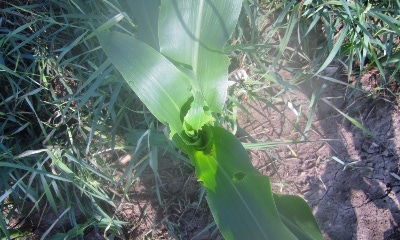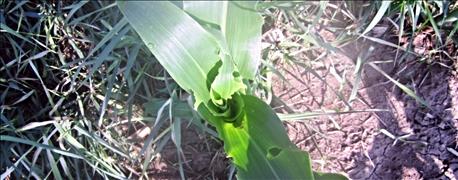July 4, 2016

As summer continues to roll on, our crops begin to surprise us with how fast they are truly growing and how they are looking out in the fields. It is a stark difference from last year.
In 2015 at this same time, farmers were gearing up to head to the fields for the first time. In so many areas, farmers did not even have a single bean in the ground due to so much rainfall.
Fast forward to this year and by the end of May into June where we had 32 days straight without a rain, putting many crops in a critical stage for some moisture. Still, the corn continues to grow.

DAMAGED: Armyworms damage to corn stalk. (Photo courtesy University of Wisconsin)
What we don't need is another problem this growing season that could impact yields. However, one common pest that comes in July and August is the black armyworm. Farmers need to remain diligent in searching cornfields as the summer pushes on, otherwise they may face reduced yields this fall.
Impact of armyworms
Walking through fields scouting corn progress it is easy just to look at the leaves of the plant and determine stalk quality of your hybrids. But take the time to look over the top part of your corn plants and you may begin to notice feeding on upper plant tissue or whirl leaves.
The most common type of damage black armyworm inflicts is to pre tassel corn. It is in this stage where the larger larvae are found closer to the whirl of the corn.
When glancing down into the whirl, armyworm will produce "frass," which is the brown muck left over from armyworms. Left unnoticed or treated, they stay in the corn plant and continue to feed until young corn ears are developed. Once young corn ears are available, armyworms can feed on corn ears leading to no grain production on that stalk.
What to expect when scouting
Typically, late planted corn fields are ones that seem to be hardest hit by black armyworm. Begin checking fields in July. While scouting, take note of any corn plants with holes in the leaves as this could be an indication of black armyworm feeding. However, try not to let it get that far. Scout early and often.
The best time to fend off a black armyworm attack is in the early larvae stage. Again, look into the corn whirl. If you find damage down into the corn whirl, stop and take notice of the armyworm size. It is the size of the armyworm that is critical for control.
When scouting, look for 5-7 plants that have been affected and determine armyworm size. Then talk to your agronomist to see the best control measure. Control of the armyworm at a smaller larva stage leads to better suppression out in your fields.
If you are scouting early, you have the chance to limit damage with an insecticide. For many this includes using a crop duster or helicopter. The main goal of airborne insecticide application is to make sure that it is applied with enough water to be placed into the whirl of the corn to affect the armyworms causing damage.
If you have any questions while scouting, talk to your local agronomist or seed supplier to help make your scouting a success.
Allen is owner of Allen Seed and Service where he scouts 3,500 acres of corn and 10,000 acres of soybeans annually. He writes from Hawk Point.
You May Also Like




